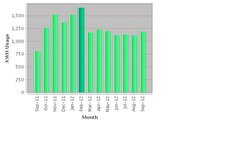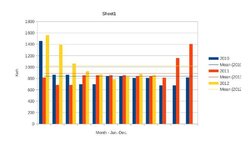I have a two-ton, two-stage Climatemaster water to air heat pump. The gross square footage of the house is nearly 4,000 sq.ft, in central NH. But this house is superinsulated, so the heat load is very low in the first place. The heat load spreadsheet I built for the house seems to be on the conservative side. Although last winter wasn't particularly severe, with only a few nights getting below zero and something like 17% fewer heating degree days for the heating season, the heat pump never had to go to second stage to keep the house at 70. As best as I can figure, by backing out shoulder season electric bills from the heating season total bills, it appears that the whole season cost me around $500 last year. I may have better numbers over the upcoming season, as I have since installed an hour meter on the heat pump.
The installation is SCW (Standing Column Well), which uses well water as a heat source; the slightly cooled water is returned to the well to regain heat from the rock around the borehole. I knew that the heat load would be small, and the house would have a new well drilled anyway for a water supply, so going geo made sense for us. We really didn't have to drill any deeper than needed to get added water supply for the house, and once they got to that point, at a depth that would support a three-ton system, I told them to stop at the end of that length of drilling pipe. So my ground connection actually will support more heat load than required. In general, for a SCW system, around 80 feet of water column is needed per ton of heat load.
Ground water in the northeast usually is plentiful and of good quality, so that for a new house in this region, which ought to be built to be very tight and well insulated, a "geothermal" (ground source heat pump) system can make a lot of sense in a rural area if a water well is needed anyway. If the drilling is an extra, or if the house isn't particulary energy efficient, then geothermal is a harder sell. In any case, designing a geothermal system must be done carefully. With a conventional system, oversizing doesn't cost much more. With Geothermal, every extra ton of capacity costs quite a bit. One could argue that for an existing house, the money might be better spent on improving the outer shell, to reduce the load, rather than look for a cheaper source of energy to waste.


 A lot of folks are getting their outside AC units stolen so it is nice to also know that I am not going to come home from work and have a missing heat pump unit.
A lot of folks are getting their outside AC units stolen so it is nice to also know that I am not going to come home from work and have a missing heat pump unit.


 I don't like that neighborhood.
I don't like that neighborhood.
